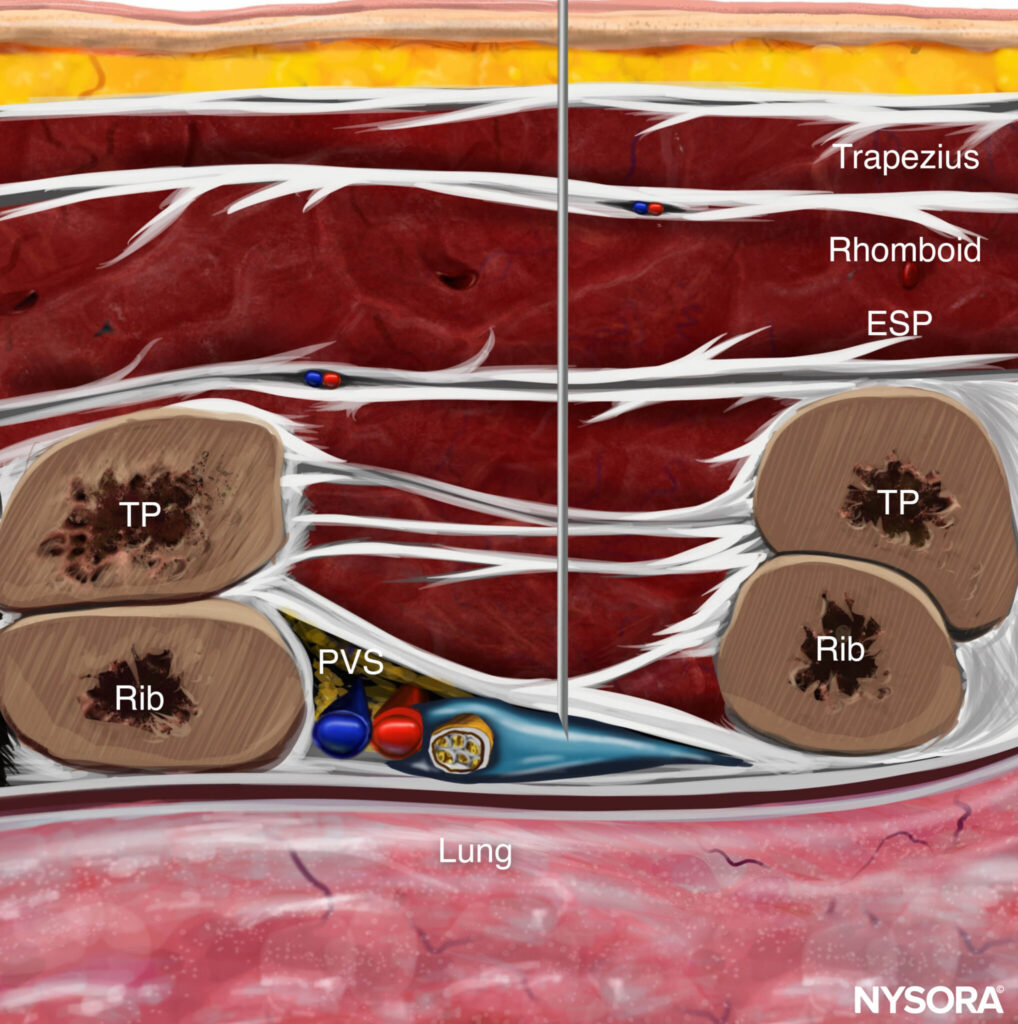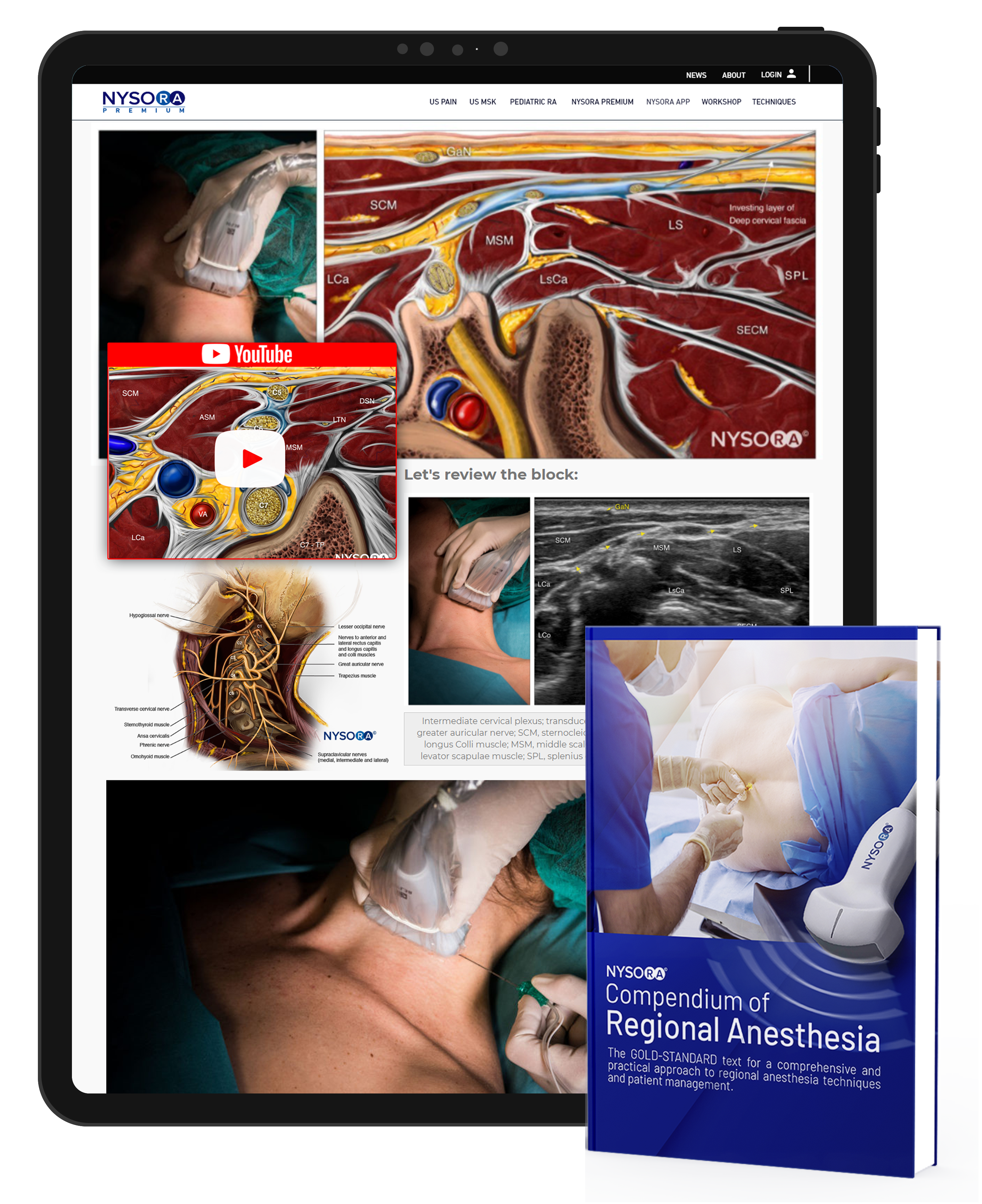Calling all anesthesiologists and pain specialists! Elevate your practice and expand your expertise with NYSORA’s Compendium of Regional Anesthesia. This comprehensive e-book, enriched with NYSORA illustrations, animations, and clinical videos, is the ultimate resource to stay ahead in the field.
Here’s why subscribing to NYSORA’s Compendium is a game-changer:
- Unparalleled Content: Our Compendium is like an e-book “on steroids.” It’s packed with in-depth, up-to-date information on all things regional anesthesia and acute pain medicine. From basic principles to advanced techniques, this single-source knowledge hub has you covered, ensuring you have the most comprehensive and reliable information at your fingertips.
- Rich Visual Experience: Say goodbye to dry, text-heavy resources. NYSORA’s Compendium comes to life with captivating illustrations, animations, and clinical videos. Visualize complex concepts, understand techniques with precision, and enhance your learning experience like never before.
- Always Updated, Never Outdated: We understand the importance of staying current in the ever-evolving field of regional anesthesia. That’s why our Compendium is always updated with the latest advancements, research findings, and emerging trends. You can trust that you’re accessing the most up-to-date information, keeping you at the forefront of your practice.
- Vibrant Community: As a subscriber, you’ll gain access to a vibrant community of fellow professionals. Engage in discussions, share clinical cases, exchange insights, and collaborate with like-minded individuals passionate about regional anesthesia. Connect with experts and foster relationships that will enhance your professional journey.
Latest Updates
We recently added 6 highly sought-after nerve block techniques to the Compendium. Stay tuned for further updates as we continue to empower healthcare professionals with the latest advancements in regional anesthesia!
Lateral femoral cutaneous nerve block
Indications: Analgesia for surgery on the anterolateral thigh (e.g., skin grafting), muscle biopsy, meralgia paresthetica
Goal: Local anesthetic spread around the lateral femoral cutaneous nerve superficial or lateral to the sartorius muscle

Transducer: Linear
Needle: 25 gauge, 4 cm
Local anesthetic volume: 3-5 mL
Obturator nerve block
Indications: Supplemental analgesia for hip and knee surgeries (considered as rescue block for knee surgery), prevention of thigh adduction response during transurethral bladder surgery, relief of painful or permanent hip adductor spasticity
Goal: Local anesthetic spread in the fascial planes containing the branches of the obturator nerve

Transducer: Linear or curved (larger patients)
Needle: 21-22 gauge, 5 or 10 cm short bevel
Local anesthetic volume: 5-10 mL in each interfascial plane or around each branch of the obturator nerve; 10-15 mL for the proximal approach
Proximal sciatic nerve block
Indications: Anesthesia and analgesia for foot and ankle surgery, procedures on and below the knee involving the posterior aspect of the knee, and above-knee amputation
Goal: Local anesthetic spread within the sheath containing the sciatic nerve

Transducer: Low-frequency curvilinear transducer (or high-frequency linear transducer for subgluteal approach)
Needle: 22 gauge, 8-10 cm insulated stimulating needle
Local anesthetic volume: 10-20 mL
Genicular nerve block
Indications: Chronic knee pain, total knee arthroplasty, or procedures associated with moderate to severe postoperative knee pain
Goal: Local anesthetic spread next to the genicular arteries (if visible) or at the junction of the epiphysis and diaphysis of the femur and tibia

Transducer: Linear
Needle: 22 gauge, 5 cm, short-bevel needle
Local anesthetic volume: 4 to 5 mL per nerve
Intercostal nerve block
Indications: Analgesia for rib fractures, postsurgical analgesia for chest and upper abdominal surgery (i.e., thoracotomy, thoracostomy, mastectomy, gastrostomy, and cholecystectomy), herpes zoster, or post-herpetic neuralgia
Goal: Local anesthetic spread in the intercostal sulcus around the intercostal nerve

Transducer: Linear
Needle: 22-25-gauge, 3-5 cm
Local anesthetic volume: 3-5 mL at each level
Paravertebral block
Indications: Analgesia after breast surgery, thoracotomy, rib fractures, and procedures involving the thoracic and upper abdominal wall

Goal: Infiltration of local anesthetic into the paravertebral space
Transducer: Linear
Needle: 80-100 mm, 21-22 gauge
Local anesthetic volume: 4-5 mL per space
Continue Learning in Compendium
Dive into the intricacies of not just these, but all 60 essential nerve blocks by immersing yourself in NYSORA’s Compendium of Regional Anesthesia. This comprehensive resource will guide you through a thorough exploration of each nerve block, equipping you with a profound understanding of its indications, techniques, potential complications, and best practices. Subscribe to NYSORA’s Compendium of Regional Anesthesia and start your 7-day free trial.
Visit our website or subscribe today to join the ranks of informed, empowered practitioners who are redefining excellence in regional anesthesia and acute pain medicine. Let NYSORA be your trusted companion on your journey to success!







